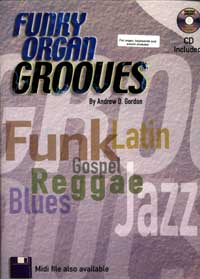
2001, A.D.G. Productions
contact: www.adgproductions.com
|
Funky Organ Grooves
- Andrew D. Gordon has composed and arranged various riffs of jazz styles like blues, funk,
gospel and others. Most of them can be played even by beginners who have a certain rhythmic
feeling (everybody who wants to play jazz should have it). To plunge deeply into the matter,
Andrew has enclosed a CD, with means of which the student can follow the notes audibly. Each
riff is repeated in a slow mood, so you can better understand the rhythmic relations. The
riffs themselves are rather short (up to 18 bars), so you can easily use them in your own
improvisations. A successful book for beginners of the jazz organ.
|
|
Outstanding Jazz
Keyboard/Organ
Solos
- This book certainly adresses to the more experienced keyboard
player. At the first glance, it is confusing to see four clefs, one for the solo,
two for the acompanying harmonies and one for the bass line. According to Gordon, it depends
on whether you are practicing playing rhythm parts or lead solo parts. The solos as well as
the rhythms demand a high level of skills.
The book contains compositions of Gordon presenting various styles like blues, latin jazz or
acid jazz. The student is supported by a CD containing the compositions played by Andrew in two
different modes.
|
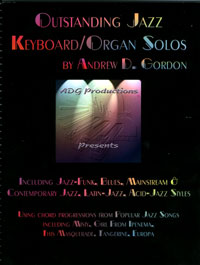
1997, A.D.G. Productions
contact: www.adgproductions.com
|
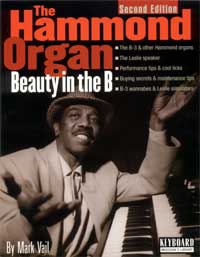
2002, Backbeat Books
contact: backbeatbooks.com
|
The Hammond Organ
Beauty in the B
- Mark Vail, formerly a member of "Keyboard" magazine's staff, presents the 2nd
edition of his well known work about the beloved Hammond organ. A history of the Hammond and the
Leslie, illustrated with a bunch of pictures, introduces the reader into the world of
the famous organ constructed by Laurens Hammond.
The various models are presented, the maintenance of a B3 is explained, and the benefit of a Leslie cabinet
is praized.
The secrets of playing the Hammond are reveiled in the section "tips from the stars". Artists like Tom
Coster, Jimmy McGriff, Keith Emerson, Joey De Francesco, John Medeski, Larry Goldings and many others
speak about registrating the draw bars and give advice how to play this unique instrument. Even
examples of scores for a better understanding come together with the tips.
Vail, in another section, presents some of the instruments which try to imitate the original. A collection
of support adresses, all of them situated in the USA, rounds up the description of the Hammond organ.
In a very last section, Vail presents something, which he calls a "hammondography": a selected discography of
albums and CDs of Hammond players, coming from the various directions.
This book is a splendid resource of all the things you wanted to know about the Hammond organ and its music,
a must have for the Hammond fan.
|
|
All Music Guide
To Jazz, 4th edition
- A guide is or should be like an encyclopedia. The All Music Guide lists artists alphabetically.
Each entry consists of a short biography and remarks about their most important albums with a scoring.
Main emphasis is, definitely, laid on artists from the USA.
An appendix introduces into the history of jazz, with music maps showing the most important
artists of their era. Also, the guide describes the jazz scenes in the various countries and gives
recommendations you should be a bit wary of. It is obvious that this guide observes the jazz world
with American eyes.
This book is an excellent encyclopedia of jazz artists apart from the above mentioned restrictions.
|

2002, Backbeat Books
contact: backbeatbooks.com
|

2002, Acoustic Music Books
contact: www.acoustic-music.de
|
Best of
Barbara Dennerlein
- A compilation of ten Dennerlein favorites from various CDs are presented as sheet music. The book
is divided into two sections: the lead sheets and the full scores.
The rhythmic elaborations of Barbara's tunes are surely ambitious, thus demanding high skills
from the player. Of course you need not play the full scores, but can move back to the lead sheets
(reminding the famous fake books) for your own improvisations.
A book for the more experienced jazz organ player written by one of the best European jazz organ players.
|
|
Spiritual
Movement No. 1
- Eight of Dennerlein's compositions for church organ are collected in this issue of sheet music.
The scores represent exactly what you can hear on the corresponding CD.
The compositions differ from one another regarding the degree of difficulty. For organists who are new to
the world of jazz this book is a good way to adopt the swinging mood, the jazzy harmonies which are surely unusual
to them. Being experienced with the pedal playing, church organ players should not have big problems
with the bass lines of Dennerlein's compositions.
On the other hand, organists who have already entered the jazz world can obtain many ideas by this book -
harmonic suites, forms of bass lines, rhythmic figures. What they can not find are propositions for any
registrations. Barbara says, that the appropriate registration should be left to the inspiration and
taste of the musician, and that furthermore the dispositions of the church organs differ too much.
A book full of compositorial ideas for the jazz organ beginner as well as for experienced players.
|

2002, Acoustic Music Books
contact: www.acoustic-music.de
|

2002, Berklee Press
contact: www.berkleepress.com
|
Hammond Organ
Complete
- Dave Limina's Hammond organ book is divided into three parts. The first one explains with a lot of details
the specific handling of drawbar organs, especially of the Hammond. David introduces several models of
such organs, but limits his further explanations to the Hammond B-3, C3 and A100.
All controls and drawbars are presented with detailed illustrations, their functionality is explained
very clearly. Dave gives some samples of drawbar settings, such as "Fat Rock" or "Classic Gospel".
The next section contains a short introduction of the Leslie speaker. A bass pedals exercise follows.
The second part is divided into 21 exercises. Various themes, such as "combining dynamics and speed
switching", "blues techniques in four keys" or "walking bass line pedal techniques in four keys" deal
with nearly all aspects of playing the Hammond organ. Each exercise contains a picture, a drawbar
illustration and a musical sample which you can practise. A CD is included with the book in order to get
a first impression of how the samples should sound. These exercises are not just that easy and demand
base knowledges and a rhythmic feeling from the player.
Part three contains some tunes for fully exploring the fines points of playing the Hammond organ.
Dave Limina's Hammond Organ Complete is absolutely recommendable for all Hammond players, even for those
who are more experienced (apart from professionals).
|
|
Freedom
The Vision
- Håkan Lewin arranged some Negro Sprituals for a solo instrument and organ (pipe organ or Hammond).
Six of them are published in this score book and can be heard on the CD
Freedom - The Vision interpreted by three instruments: a sax, a Hammond organ and a church organ.
The arrangements are not that easy to play, at least what concerns the organ part. They demand a more experienced
player who is able to follow bass lines on the pedal and to play complicated jazz harmonies.
|
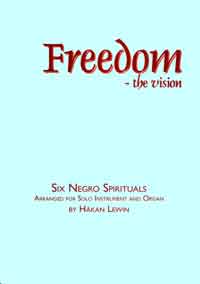
2003, Wessmans Musikförlag, Slite/Sweden
contact: www.ellingtonandmore.com
|
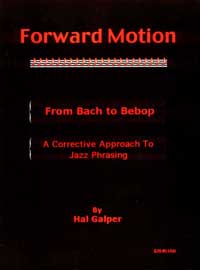
2004, Hal Galper
contact: www.halgalper.com
|
Forward Motion
From Bach To Bebop
-
Hal Galper's Corrective Approach To Jazz Phrasing - the subtitle of this book - is an ambitious
work, obviously written for those students who are willing to plunge deeply into musical practice.
"Jazz is a music that is based on learning by listening to the music 28 hours a day," says Hal, and
strongly encourages his readers to organize their practicing individually. Hal, being himself a
pianist, does not adress to keyboard players explicitly. What he says in his book, is equally valid for
all who want to play jazz on whatever instrument.
Phrasing is the secret word - and Hal starts just at the epitome of the composers - Johann Sebastian
Bach, who could have been himself a jazz player with all his fantastic art of improvisation. "In a
Bach theme everything surges forward to a principal accent", Hal puts it in a nutshell. In the 10
chapters to follow, the author deals with themes such as rhythmic Forward Motion (FM), scalar FM,
harmonic FM, superimposition, the practicing of FM, and much more.
Hal's book is not for reading during the breakfast, but for hard working with, recommendable for
all who want to play jazz or believe they are already pros. Improve your jazz live with FM!
|
|
The Right
Combination
-
The Right Combination consists of three chorale arrangements by Liselotte Kunkel which transform hamonic and
rhythmic elements from classic swing jazz into forms in keeping with organ performance.
The title not only refers to the somewhat unusual scoring, which has two organists at one
instrument, but also the fact that two hymn melodies common in the protestant as well as in
the roman catholic church are combined in each of the three movements. Additionally, the
title refers to the combination of stops necessary for performing the work.
|
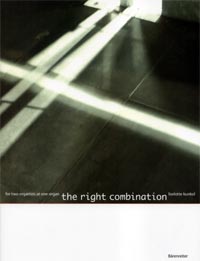
2006, Bärenreiter-Verlag, Kassel/Germany
contact: www.baerenreiter.com
|
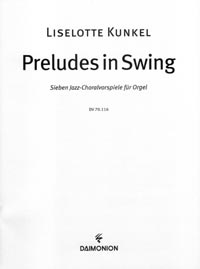
2002, Daimonion
contact: daimonion.de
|
Preludes in Swing
-
Choral preludes are elementary parts of services both in catholic and protestant churches.
Kunkel has arranged seven such preludes in a jazzy way, with touches of gospel and spirituals.
To play these compositions, the organist should be (or get) familiar with jazz harmonies and
rhythms to let swing these preludes in the rigth way.
|
|
Swing Twice
-
A second volume of four choral preludes are presented by Liselotte Kunkel. In this volume,
for each prelude two versions are offered, a shorter and a longer one, the longer versions
coming in different styles such as a toccata, a waltz, a fuguette or a blues.
|
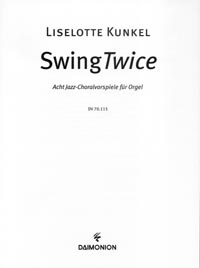
2002, Daimonion
contact: daimonion.de
|

2001, Strube
contact: strube.de
|
Preludes in Swing
-
Kunkel has composed 10 choral preludes of both the catholic and protestant churches. They combine
chorals with harmonic and rhythmic elements typical for jazz. Kunkel points out that there is room
for free improvisations, as these compositions derive from improvisations. As said before, Kunkel's
choral preludes demand certain skills to be able to play them. The size of the organ is not
decisive, the voices can easily be adopted to its possibilities.
|
|
Das Pedal-Solo Buch
-
Johannes Matthias Michel, the organist of the Christuskirche in Mannheim/Germany, has presented
a unique series of compositions: choral preludes, variations and dances for the pedal only.
Apart from being a fantastic exercise, these pieces show that you can play real music with
solo pedal. Some of the compositions demand both feet at the same time, even with 3 and 4 tone
chords. The highlight is the adaptation of Johann Strauß' waltzes for 4 feet.
|

2002, Strube
contact: strube.de
|
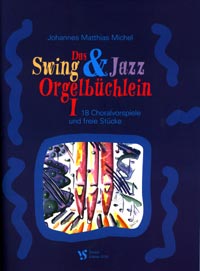
1997, Strube
contact: strube.de
|
Das Swing & Jazz
Orgelbüchlein 1
-
Chorals seem to be a perfect subject for jazzy adaptations. Also J.M. Michel has written 18 pieces the basis of which
are chorals, mainly from the protestant song book. Some of these are divided into 2 parts: a kind of prelude based on
rhythms like Boogie, and an accompaniment using jazzy chords.
|
|
Das Swing & Jazz
Orgelbüchlein 2
-
In his second swing and jazz booklet J.M. Michel presents a "Suite Jazzique" consisting of Grand Choeur, Prière,
Menuett Jazzique, Cantilène and Toccata Jazzica, as well as some further choral preludes. Also Michel's
choral preludes demand certain skills to be able to play them.
|
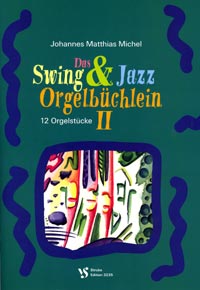
2003, Strube
contact: strube.de
|
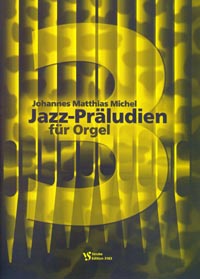
1999, Strube
contact: strube.de
|
Jazz-Präludien für Orgel
-
Three preludes for the organ composed by J.M. Michel are compiled in this booklet. The first piece consists
of a five-fourth rhythm, called "Swing Five"; the second, dedicated to Barbara Dennerlein, is called "Bossa Nova".
The third composition, "Afro-Cuban" is a tribute to Leonard Bernstein. All three are challenging pieces.
|
|
Play Bach -
Play Jazz
-
Many artists have based their jazz improvisations on themes of J.S. Bach. But you won't hardly find any jazz compositions
which follow Bach's music so you can play it at your own - if you have the skills to do so. Liselotte Kunkel's 5th release
of jazzy compositions presents five pieces of Bach. Some of them are modified by an A-B-A-B pattern, where A is the (more or less)
original music and B a jazzy change. Kunkel has chosen a fugue, two choral preludes (one of which is the famous "Wachet auf"), the Badinerie
from the orchester suite in B minor and changes on the Air.
This sheet book is a real chance to plunge into Play Bach, not only to listen to, but play it yourself.
|

2008, Ostinato
contact: ostinato-music.de
|
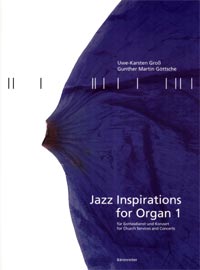
2003, Bärenreiter-Verlag, Kassel/Germany
contact: www.baerenreiter.com
|
Jazz Inspirations
For Organ Vol. 1
-
This compilation of various composers is subtitled "for church services and concerts". In fact, this first volume
offers mostly choral preludes of very different styles. The composers have used as basis for their works Christian chorals
of ancient times ("Wer nur den lieben Gott läßt walten") as well as modern songs ("Danke") or spirituals
("Go Tell It On The Mountain"). 13 composers, most of them of German origin, have contributed 33 compositions.
Demanding fundamental skills and a feeling for jazz rhythm, this book is nevertheless an excellent source for
organists who like to immerge the jazzy way of playing the organ.
|
|
Jazz Inspirations
For Organ Vol. 2
-
Volume two holds ready nine non-liturgical works such as a "Petite Suite In Blue" by J.M. Michel, a ragtime by H.M. Kiefer or
"Swinging Pipes" by M. Nagel. Michel's suite is remarkable, it consists of five movements (Entrée, Récit, Scherzo, Blues,
Sortie) which reminds of a French suite. Anyhow, these nine compositions are suitable for all organs on nearly all occasions.
Additionally, this book comes with further ten choral preludes of different styles, similar to those in volume one.
|
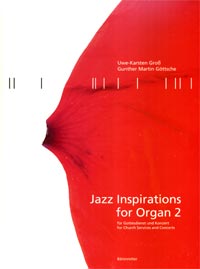
2006, Bärenreiter-Verlag, Kassel/Germany
contact: www.baerenreiter.com
|
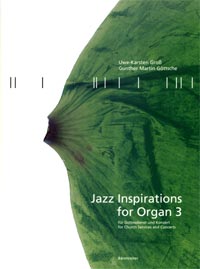
2007, Bärenreiter-Verlag, Kassel/Germany
contact: www.baerenreiter.com
|
Jazz Inspirations
For Organ Vol. 3
-
Also the third volume of Jazz Inspirations For Organ contains non-liturgical and liturgical organ works.
Among others G. Berger presents a partita in five movements (Bossa Nova, Brazilian samba, Hardbop,
bright swing, five time blues). Also very interesting are two jazz arrangements by L. Kunkel about "On A Clear Day" and "Twilight World".
|
|
12 Studies
For Hammond Organ
-
Vito di Modugno, jazz organist from Italy, has released these twelve studies which cover various jazz styles,
not just for beginners. They contain also registration suggestions. This book can be of good help for those
players who have first experiences in jazz organ.
|
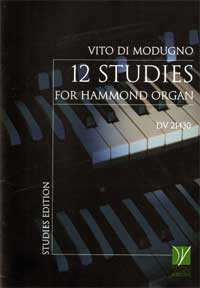
2019, Da Vinci Publishing, Italy
contact: www.davinci-edition.com
|

2019, Saxo København
contact: www.jensmorsing.dk
|
Waltz For Barbara
-
Danish organist Jens Morsing found his way to the jazz on pipe organ by Barbara Dennerlein whose
way to play this instrument had impressed him. He now presented a composition in c minor which he
dedicated to Barbara. It's a rather simple melody with common jazz harmonies which can be played
even by the less experienced organist. Of course you can improvise using the melody as a base.
The scores supply also a lead sheet for the more experienced player.
|
|
Hammond B-3
Organ Trios
and Soul Jazz
1955-1965
-
Nelsen Hutchison published his thesis submitted in partial satisfaction of the requirements for the degree of MASTER OF ARTS in MUSIC at the University of California, Santa Cruz in 2017. This master thesis is structured in three parts:
1: Jazz Organ History
2: Soul Jazz and The Critic
3: Musical Characteristics
and contains an extended bibliography and a somewhat tiny discography. The author says:
"Hammond B-3 organ trios (organ, guitar, and drum set) were a distinctive part of the jazz soundscape from the mid-1950s and throughout the 1960s. Stylistically they tended to play in a genre termed "soul jazz" and incorporated elements of black popular music such as the blues, R&B, and gospel. Drawing on archival and secondary sources, I provide a history of the Hammond organ and its role in the music we can call jazz as well as an analysis of the critical discourse surrounding the Hammond B-3 and soul jazz. I use Henry Louis Gates Jr.'s theory of signifyin(g) and the trope of call and response as a framework to analyze transcribed excerpts of Hammond organ groups and discuss some of their salient musical characteristics. Finally, I aim to situate them within a larger history of African American music, particularly with regard to the relationships between the sacred, the secular, and art."
|
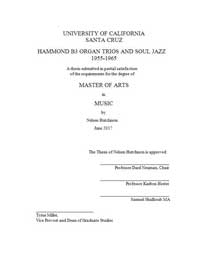
2017, University of California
You can read this thesis at escholarship.org
|

2017, © Darren Heinrich
If interested please contact Darren.
|
The Afrological
Soul Of Jazz Organ
-
Darren Heinrich, jazz organist from Australia, offers in his doctoral thesis a practitioner's perspective of jazz performance on the Hammond organ in the areas of history, cultural location, improvisational vocabularies & performance paradigms. He draws on famous organists such as Milt Buckner, Wild Bill Davis, Marlowe Morris, and Jimmy Smith. This research contains also some transcriptions of Jimmy Smith titles.
|

























